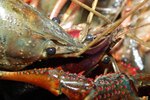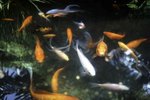
When you're selecting plants for a goldfish pond, the choices can seem overwhelming. However, most pond plants fit neatly into a few categories. These categories make it easier to narrow down what kind of plant is best for you. Pond plants from these different categories can each play a role in the overall design of a pond.
Floating
True floating plants do not put out roots or try to attach themselves to the substrate. Many contain air spaces within their tissues that allow them to float. Duckweed (Lemna spp.) and water hyacinth (Eichornia crassipe) are both examples of these plants. Floating plants can provide shade for goldfish ponds. In the case of water hyacinth, the plant grows rapidly and will absorb excess nutrients from the pond, discouraging the growth of unsightly algae. At the same time, goldfish often like to nibble on the underside of floating plants for extra nutrition.
Rooted Floating
Rooted floating plants are similar to true floating plants, though they attach themselves to the substrate. Water lilies are an example of this type of plant. Water lilies make up the family Nymphaea and have over 70 individual species, plus artificially selected varieties and hybrids. Different water lilies need to be planted at the correct depth. They require more work than true floating plants, but can produce beautiful flowers.
Submersed
Submersed plants are plants that are adapted to live completely underwater. While a person viewing the pond might not appreciate them as much as something like a water lily, they help goldfish feel safe by providing cover, while producing oxygen for the fish. These plants must be rooted in the substrate. Cabomba spp. and Anacharis spp. are fast-growing examples of this type of plant.
Emergent
Emergent plants, also called marginal or bog plants, are useful in decorating the pond. They usually live near the edge of water, and grow from the pond. The difference between these and something like a rooted floating plant is that emergent plants have stems hard enough to support them outside of water. Like other pond plants, they suck nutrients out of the water and discourage algae blooms. Some larger bog plants, like the umbrella palm (Cyperus spp.) can provide shade for a goldfish pond and discourage overheating.
References
Photo Credits
-
Jupiterimages/Photos.com/Getty Images



